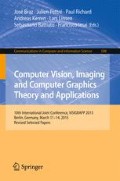Abstract
In exploratory data analysis, important analysis tasks include the assessment of similarity of data points, labeling of outliers, identifying and relating groups in data, and more generally, the detection of patterns. Specifically, for large data sets, such tasks may be effectively addressed by glyph-based visualizations. Appropriately defined glyph designs and layouts may represent collections of data to address these aforementioned tasks. Important problems in glyph visualization include the design of compact glyph representations, and a similarity- or structure-preserving 2D layout. Projection-based techniques are commonly used to generate layouts, but often suffer from over-plotting in 2D display space, which may hinder comparing and relating tasks.
Inspired by contour and venation shapes of natural leafs, and their aggregation by stems, we introduce a novel glyph design for visualizing multi-dimensional data. Motivated by the human ability to visually discriminate natural shapes like trees in a forest, single flowers in a flower-bed, or leaves at shrubs, we design a flexible leaf-shaped data glyph, where data controls main leaf properties including leaf morphology, leaf venation, and leaf boundary shape. Our basic leaf glyph can map to more than a dozen of numeric and categorical variables. We also define custom visual aggregation schemes to scale the glyph for large numbers of data records, including prototype-based, set-based, and hierarchic aggregation. We show by example that our design is effectively interpretable to solve multivariate data analysis tasks, and provides effective data mapping. The design provides an aesthetically pleasing appearance, and lends itself easily to storytelling in environmental data analysis problems, among others. The glyph and its aggregation schemes are proposed as a scalable multivariate data visualization design, with applications in data visualization for mass media and data journalism, among others.
Access this chapter
Tax calculation will be finalised at checkout
Purchases are for personal use only
References
Deussen, O., Lintermann, B.: Digital Design of Nature. Springer, Heidelberg (2005)
Borgo, R., Kehrer, J., Chung, D.H., Maguire, E., Laramee, R.S., Hauser, H., Ward, M., Chen, M.: Glyph-based visualization: foundations, design guidelines, techniques and applications. In: Proceedings of Eurographics, Eurographics, pp. 39–63 (2012)
Ward, M.: Multivariate data glyphs: principles and practice. Handbook of Data Visualization. Springer Handbooks Computer Statistics, pp. 179–198. Springer, Heidelberg (2008)
Cleveland, W., McGill, R.: Graphical perception: theory, experimentation, and application to the development of graphical methods. J. Am. Stat. Assoc. 79, 531–554 (1984)
Siegel, J., Farrell, E., Goldwyn, R., Friedman, H.: The Surgical Implications of Physiologic Patterns in Myocardial Infarction Shock. Surgery 72, 126 (1972)
Pickett, R.M., Grinstein, G.G.: Iconographic displays for visualizing multidimensional data. In: Proceedings of the Conference on Systems, Man, and Cybernetics, pp. 514–519. IEEE (1988)
Ware, C.: Information Visualization: Perception for Design. Morgan Kaufmann, Waltham (2012)
Du Toit, S.H., Steyn, A.G.W., Stumpf, R.H.: Graphical Exploratory Data Analysis. Springer-Verlag, New York (1986)
Kintzel, C., Fuchs, J., Mansmann, F.: Monitoring large IP spaces with clockview. In: Proceedings Symposium on Visualization for Cyber Security, p. 2. ACM (2011)
Levkowitz, H., Herman, G.: Color scales for image data. IEEE Comput. Graph. Appl. 12, 72–80 (1992)
Fuchs, J., Fischer, F., Mansmann, F., Bertini, E., Isenberg, P.: Evaluation of alternative glyph designs for time series data in a small multiple setting. In: Proceedings Human Factors in Computing Systems (CHI), pp. 3237–3246. ACM (2013)
Chernoff, H.: The use of faces to represent points in k-dimensional space graphically. J. Am. Stat. Assoc. 68, 361–368 (1973)
Chuah, M.C., Eick, S.G.: Information rich glyphs for software management data. IEEE Comput. Graph. Appl. 18, 24–29 (1998)
Klassen, R.V., Harrington, S.J.: Shadowed hedgehogs: a technique for visualizing 2D slices of 3D vector fields. In: Proceedings of the 2nd conference on Visualization 1991, pp. 148–153. IEEE Computer Society Press (1991)
Flury, B., Riedwyl, H.: Graphical representation of multivariate data by means of asymmetrical faces. J. Am. Stat. Assoc. 76, 757–765 (1981)
Jacob, R.: Facial representation of multivariate data. In: Graphical Representation of Multivariate Data, pp. 143–168. Academic Press (1978)
Surtola, H.: The effect of data-relatedness in interactive glyphs. In: Proceedings of IV, pp. 869–876 (2005)
Stefaner, M.: The deleted (2014). http://notabilia.net/
Müller, B.: Poetry on the road (2014). http://www.esono.com/boris/projects/poetry05/
Kleiberg, E., van de Wetering, H., van Wijk, J.: Botanical visualization of huge hierarchies. In: IEEE Symposium on Information Visualization, 2001, INFOVIS 2001, pp. 87–94. IEEE (2001)
Sallaberry, A., Fu, Y.C., Ho, H.C., Ma, K.L.: Contacttrees: ego-centered visualization of social relations. Technical report (2012)
Stefaner, M.: Oecd better life index (2014). http://moritz.stefaner.eu/projects/oecd-better-life-index/
Beck, C.B.: An introduction to plant structure and development: plant anatomy for the twenty-first century. Cambridge University Press (2010)
Palmer, S.E.: Vision Science: Photons to Phenomenology, vol. 1. MIT press Cambridge, MA (1999)
Porter, T., Duff, T.: Compositing digital images. In: Proceedings of the 11th Annual Conference on Computer Graphics and Interactive Techniques. SIGGRAPH 1984, pp. 253–259. ACM, New York (1984)
Cortez, P., Morais, A.D.J.R.: A data mining approach to predict forest fires using meteorological data (2007)
Han, J., Kamber, M., Pei, J.: Data Mining: Concepts and Techniques, 3rd edn. Elsevier Ltd., Oxford (2011)
Acknowledgements
This work has been supported by the Consensus project and has been partly funded by the European Commission’s 7th Framework Programme through theme ICT-2013.5.4 ICT for Governance and Policy Modelling under contract no. 611688.
Author information
Authors and Affiliations
Corresponding author
Editor information
Editors and Affiliations
Rights and permissions
Copyright information
© 2016 Springer International Publishing Switzerland
About this paper
Cite this paper
Fuchs, J., Jäckle, D., Weiler, N., Schreck, T. (2016). Leaf Glyphs: Story Telling and Data Analysis Using Environmental Data Glyph Metaphors. In: Braz, J., et al. Computer Vision, Imaging and Computer Graphics Theory and Applications. VISIGRAPP 2015. Communications in Computer and Information Science, vol 598. Springer, Cham. https://doi.org/10.1007/978-3-319-29971-6_7
Download citation
DOI: https://doi.org/10.1007/978-3-319-29971-6_7
Publisher Name: Springer, Cham
Print ISBN: 978-3-319-29970-9
Online ISBN: 978-3-319-29971-6
eBook Packages: Computer ScienceComputer Science (R0)

